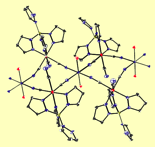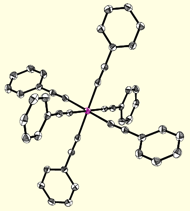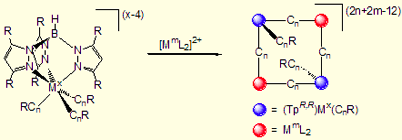Relative to cyanide-based analogues, more efficient Cn-mediated superexchange and electron transfer between metal centers is anticipated for polynuclear complexes containing M-(Cn)-M´ units. Additionally Cn ligands are not susceptible to linkage isomerism as the terminal atoms are identical (unlike cyanide). The alkynyl ligand orbitals should also be closer in energy to those of the transition metal centers and orbital symmetry arguments developed for cyanometalate materials should allow for prediction of magnetic exchange interactions. Furthermore, efficient spin delocalization via superexchange should strongly couple Cn-linked transition metal centers and afford clusters that exhibit tunable optical and magnetic properties, as a function of transition metal centers utilized.



Organometallic Materials
Research Projects
Polymerization
Current Funding
NSF CAREER,
CHE 0645414, (2007-2012)
UMSL Start-up (2008-2010)

Selected Publications
Mungaliamane, A.; Rath, N.; Holmes, S. M., in preparation.
[1]


If the M-(Cn)-M´ units can be constructed such that efficient electronic communication and superexchange interactions are present, a variety of magnetic and electroactive polynuclear complexes may be prepared, whose magnetic properties persist at higher temperatures than cyanide-based derivatives (below left). Lastly few polynuclear magnetic acetylide and butadiynylide complexes are known making these interesting targets for study. The structure of a recently prepared hexaacetylide complex is illustrated below (right).
